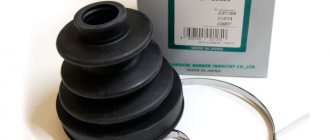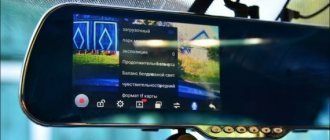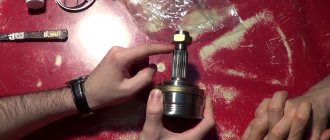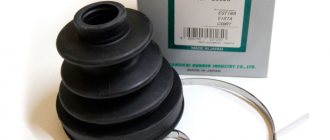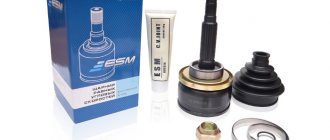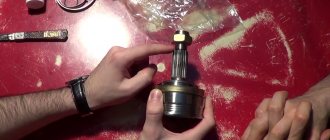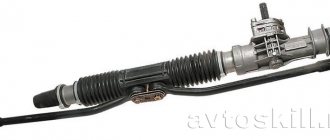Associated parts of the vehicle need protection. The presence of lubricants at interaction points (nodes) requires the use of special covers that prevent the leakage and ingress of third-party particles (dust, dirt, water, etc.). This is the answer to the question “what is a car boot?” — protective rubber casing .
Car boots can be of different shapes and sizes - in the form of a ring, similar to an oil seal, in the shape of a bell, or elongated. But they all have one function - protection of a hinge or other type of friction joint.
Damage to the boot is a serious problem. Even the smallest crack in its design can lead to the entry of dust and moisture. Due to contamination, an abrasive will form, which will lead to accelerated wear of the part, operational problems and corrosion.
Since the anthers are exposed to various types of influences, they require periodic inspection and assessment of their condition, so as not to miss the moment when it is time to change them, and to prevent damage to the connection itself.
In order to perform its functions flawlessly, the boot must have the following properties
:
- elasticity of the material (for moving parts);
- adaptability to work at different temperatures;
- resistance to aggressive external environment;
- no reaction to fuels and lubricants.
The original part fully complies with the presented list of properties and is a more reliable option than any high-quality copy or analogue.
Next, let's look at what types of anthers are found in cars.
CV Boot Replacement Kit
What is a car boot?
Interconnected parts of the car require constant protection.
The presence of various lubricants in the units (interaction points) requires the use of covers that prevent the leakage of lubricant, as well as the ingress of various microparticles (dust, water, dirt, etc.). These protective special covers are made of rubber and are called anthers. They can be of completely different sizes and shapes, for example, elongated or bell-shaped, but they all have only one purpose - to protect any rubbing joint (hinge or any other). Any damage to the boot is a fairly serious nuisance, because even the smallest crack will lead to moisture and dust getting into it. This creates an abrasive that can lead to faster wear, corrosion, and operational problems.
Since the anthers are subject to various influences, it is necessary to constantly check their condition. This is necessary so that you can replace them with new ones in time, thereby preventing disruptions in the operation of the unit protected by the anthers.
For the boot to do its job perfectly, it must have the following characteristics:
- The material used for manufacturing must be elastic;
- The boot must be adapted to function under a wide variety of temperature conditions and be resistant to aggressive environments;
- There should be no reaction to fuels and lubricants.
Wear resistance
The material used in the production of the boot must withstand very heavy loads.
- High temperatures, should not melt or crack at extreme positive temperatures.
- Low temperatures, should not “tan” in frosts
- Should cope well with wear, i.e. protection against friction
- Breaking work. Must withstand torsion and fracture
Previously, anthers were made mainly of rubber, but this material was far from perfect, so it could dry out in the summer and could also become tan in the winter. Small cracks or even breakthroughs appeared.
Therefore, then the production technology was changed a little; now new rubber compounds with improved characteristics or more advanced silicones are used. In any case, the boot must be very durable to withstand high loads, because its service life is calculated to last many thousands of kilometers.
CV boot
CV joint is a part of every car with front-wheel drive. Its design provides for 2 “grenades” (the second name for CV joints) on each side (one internal and the other external), each of them is protected by an external CV joint boot and an internal CV joint boot, respectively. They are usually made of silicone or neoprene to provide protection even under the most difficult conditions.
In appearance, the CV joint boots resemble a cone, which is folded like an accordion. This shape was chosen for a reason - thanks to it, the part can be protected from pinching when the angle changes. The boot is fixed on both sides with clamps, which help to reliably protect the hinge from dust.
If the drive is regularly inspected, any damage to the boot can be noticed in time. If you find the slightest crack or other defect that could break the seal, you must immediately replace the boot with a new one.
Replacing the boot is not such a difficult task, but it is quite troublesome. The first step is to dismantle the drive. Next, after completing this process, the damaged boot is cut and then the grenade is removed. Before putting a new boot on the hinge, you need to wash it and then apply lubricant. If everything is done, you can return the parts back to their place.
Clamps, as well as a damaged boot, must be replaced and cannot be reused. You can find out more about replacing the CV joint boot in the article “Replacing the outer CV joint and CV boot.”
Symptoms of breakdowns
And it’s worth talking a little about the obvious signs that the grenades are out of order. This is not a very pleasant moment, as it can hurt your wallet. For example, owners of domestic cars will have to pay at least 3,000 rubles just for a set of spare parts for repairing drives. What can we say about the happy owners of prestigious Nissan and Ford models, the CV joint boot (internal or external) of which costs the same as a joint on a “nine”.
The first sign of a mechanism malfunction is the appearance of extraneous sounds, especially when driving away with the steering wheel turned to the side. When I straighten the steering wheel everything disappears. But you can confuse the breakdown of a grenade with a malfunction of the ball joint - it also crunches when the play in it increases. Therefore, before making a final diagnosis, it is worth checking the entire suspension to identify the maximum number of defects.
Tie rod boot
Anthers are also used in the steering. Their shape, as well as their fastening, are determined by the specific design. The difficulty of replacing the boot directly depends on where they are attached:
- If the boot is located in the place where the steering rods are attached to the rack, as, for example, in the “nine”, then you will have quite a difficult time, since to replace it you need to perform a number of procedures, which include disassembling the steering mechanism.
- In VAZ cars, the anthers are usually located at the ends of the rack. To replace any of them, you will only need to remove the clamps, then unscrew the nut that secures the rod, disconnect it and remove the boot.
- Among the many types of anthers you can find some very interesting ones. For example, in one of the Volkswagen models they are made in the form of elastic caps, which are put on the body and secured with clamps. Such boots protect the steering mechanism from dirt and are quite easy to change.
Ball joint boot
This type of anther differs from the models described above in that their design resembles a mushroom, where the narrow part fits tightly to the finger, and the wider part is located on the body of the support itself. A retaining ring is used to secure the boot.
Replacing a damaged ball joint boot is quite easy. You just need to disconnect the hub and support, and then carefully pry up the retaining ring with a screwdriver. After you have done this, you can safely remove the boot from the support. Before installing a new boot, it is necessary to wash all surfaces as thoroughly as possible and also lubricate them.
The same boots are used for tie rod ends - they are absolutely identical (both the design itself and the method of replacement). Size is the only thing that makes them different.
Where is it used?
Basically, the anthers are installed on the moving elements of the front and rear suspensions, for each unit they are different and differ in design, as can be found on:
- Shock absorbers, many will now say that these are not anthers, but covers, but essentially the function is the same, so you can attribute them here. In fairness, it is worth noting that sometimes they are plastic, not rubber.
- CV joints Front grenades are also protected by rubber covers
- Steering rack. There are only two of them here
- Ball joints and steering ends
- On the clutch fork (manual transmission)
- Some stabilizer models
To be honest, in various modifications of the car there can be quite a lot of different ones. For example, many automakers even protect door pulls with such covers. I once read information that there can be about 40 - 60 dust boots in a car, but only 10 - 20 perform really important tasks.
Shock absorber boot
These boots are used to protect shock absorbers; they are usually made in the form of a corrugated rubber cover and quite often are not secured at all. They are held in place due to a good fit, and their purpose is to protect the rod from dust and dirt. As always, there are exceptions - the VAZ “classic”, where a metal cover is used. It, of course, provides longer-lasting protection, but is less effective than its relatives made of rubber.
Thanks for subscribing!
The requirements for the material from which the anthers are made are very high, because in order to function as needed under overload conditions, it must withstand a fairly wide temperature range. In addition, it must be durable and not be destroyed when it gets exposed to oil or salt, which is used to treat roads in winter.
Question of material selection
Although experts say that when choosing a boot you should be guided primarily by the manufacturer and price, in reality it is also worth considering the material of the product . For example, the most common rubber boots have many disadvantages that a competent car enthusiast should know about. Further we will talk only about non-original anthers and their most common “diseases”. Here are the main problems with rubber boots:
- Small operational resource. It is 6 months on average and up to 18 months at best;
- Low frost resistance. The anthers quickly “tan” in severe frosts.
Rubber products have an affordable price tag and are easy to change. This is partly why rubber boots are considered one of the automotive consumables along with brake pads, windshield wiper blades and filters. True, it is far from necessary to change the boot, but it is highly advisable - this will prevent the grenade from quickly failing. Regarding the disadvantages of thermoplastic products:
- Geometry problems. This applies to non-original boots - they simply jump out of place or do not fit tightly enough to the hinge, allowing water and dirt to pass through the gap;
- Installation problems. Band clamps do not always hold the boot well enough, and if they are not installed and tightened correctly, they will loosen after just a few months of use.
If the original equipment of the car includes thermoplastic boots, you can be sure that the seal will last a long time - up to 10 years . But its clamps can quickly become loose. In the case of non-original boots, problems with clamps are almost always observed. The manufacturer is trying to solve the problem of gaps between the product and the grenade using special sealants, but special chemical compounds do not last long enough on thermoplastic-metal vapors - the sealant quickly becomes ineffective. Ideally, a thermoplastic product should be blown with a construction hairdryer before installing it on the CV joint. Regarding the disadvantages of silicone anthers:
- Excessive flexibility of the material and low strength when twisted and when hit by small sharp stones when driving on poor roads/off-road;
- High softness, affecting the fit of the boot. Even tightly tightened clamps after a while stop holding the boot and it jumps off, which is why small gaps form between it and the grenade.
Spare parts for Renault 10
Distilled water
10 sedan (11.65 - 10.71)
Spare parts for Renault 18
Intake valve guide 18 wagon (135) (05.79 - 07.86)
In theory, a sufficiently thick silicone boot can have high wear resistance and almost absolute protection from temperature changes and the effects of chemicals. Unfortunately, due to the high cost of silicone, manufacturers are trying to save money by producing thin anthers , which have a longer service life than their rubber counterparts, but in practice they are not superior to them in almost anything. Preference should be given to fairly thick silicone boots - they do not tear when twisted and last much longer than their rubber counterparts. However, even thin silicone boots can be installed on cars that are used exclusively in the city.
Polyurethane anthers boast the greatest strength and wear resistance. At the same time, the main disadvantage of thermoplastic products - the high risk of gaps appearing between the product and the grenade - is also typical for them. Such anthers can be difficult to select for your car and install correctly. One of the latest innovations on the auto parts market is collapsible polyurethane CV joint covers. Unfortunately, they are quite expensive and do not provide the service life that manufacturers promise. Ease of installation comes at the cost of an increased risk of gaps. They are produced mostly by Turkish companies.
Brake caliper boot
There are two types of caliper boots - one of them is intended for the guide, and the second protects the piston. They differ in shape, but both are made of a springy material that can withstand overloads and protect the caliper from dust.
Quite often, a car boot is changed during scheduled repairs. If you find any damage, it is best to immediately replace the worn part with a new one. A replacement that is not carried out on time can very well lead to very sad consequences.
Flywheel boot
This boot especially stands out among the rest. Metal is used to make it - this is its main difference from other variations. The flywheel boot is designed to reliably protect the part itself from the ingress of third-party liquids or particles, which is why it has a second name - the clutch housing cover.
Of course, just like other parts, it can be mechanically damaged or worn out. If it is not possible to restore its working condition, then it must be replaced.

